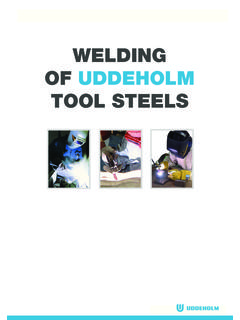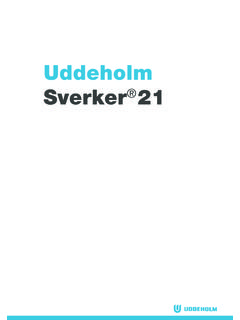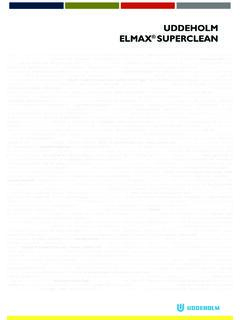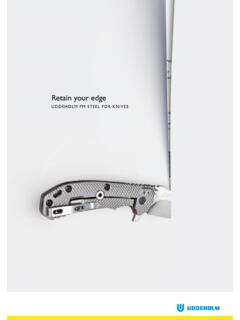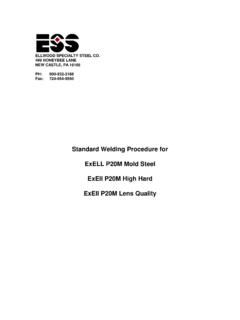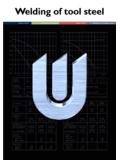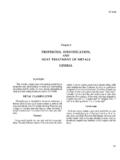Transcription of WELDING OF TOOL STEEL - Uddeholm Global
1 WELDING OF tool STEELSS-EN ISO 9001SS-EN ISO 14001 This information is based on our present state of knowledge and is intended to provide generalnotes on our products and their uses. It should not therefore be construed as a warranty ofspecific properties of the products described or a warranty for fitness for a particular according to EU Directive 1999/45/ECFor further information see our Material Safety Data Sheets .Edition 6, Revised and , not printedThe latest revised edition of this brochure is the English version,which is always published on our web site OF tool STEEL3 CONTENTSG eneral information on WELDING of tool STEEL .. 4 WELDING methods for tool STEEL .. 4 The WELDING bay .. 6 Filler material .. 7 Hydrogen in tool STEEL .. 8 Elevated working temperature .. 9 WELDING procedure .. 10 Het treatment after WELDING .. 11 Guidelines for WELDING in hot work tool STEEL .. 13 cold work tool STEEL .. 14 plastic mould STEEL .
2 174 WELDING OF tool STEELG eneral informa-tion on WELDING oftool steelTo ol STEEL contain up to carbonas well as alloying elements such asmanganese, chromium, molybdenum,tungsten, vanadium and nickel. Themain problem in WELDING tool steelstems from its high cool quickly once the heatsource is removed and the weldmetal and part of the heat-affectedzone will harden. This transformationgenerates stresses because the weldis normally highly constrained, with aconcomitant risk for cracking unlessgreat care is what follows, a description isgiven of the WELDING equipment, WELDING methodsfor tool steelShielded metal-arc WELDING (SMAW or MMA)PRINCIPLEAn electric arc generated by a DC orAC power source is struck betweena coated, rod-like electrode and thework-piece (Fig. 1).The electrodes consist of a centralwire core, which is usually low-carbon STEEL , covered with a coatingof pressed powder (flux). The consti-tution of this coating is complex andconsists of iron powder, powderedferro-alloys, slag formers and a suit-able binder.
3 The electrode is con-sumed under the action of the arcduring WELDING and drops of moltenmetal are transferred to the work-piece. Contamination by air duringthe transfer of molten drops fromelectrode to workpiece and duringsolidification and cooling of the welddeposit is inhibited partly by slagformed from constituents in the elec-trode coating and partly by gasescreated during melting of the composition of the depositedweld metal is controlled via the con-stitution of the electrode SOURCEFor MMA WELDING , it is possible touse either an AC or DC powersource. However, whichever is used,the source must provide a voltageand current which is compatible withthe electrode. Normal arc voltagesare: normal recovery electrodes:20 30 V high recovery electrodes:30 50 VUddeholm WELDING consumables areof normal recovery type. A suitablepower source for these is a DC unitwith an open voltage of 70 V andwhich is capable of delivering 250A/30V at 35% technique and weld con-sumables that are required in orderto weld tool STEEL successfully.
4 Ofcourse, the skill and experience ofthe welder is also a vital ingredient inobtaining satisfactory results. Withsufficient care, it is possible toachieve weld repairs or adjustmentswhich, in terms of tooling perform-ance, are hardly inferior to that of thebase of tooling may be requiredfor anyone of the following reasons: refurbishment and repair ofcracked or worn tooling renovation of chipped or worncutting edges, on blanking tools adjustment of machining errors intool making design changesWELDING OF tool STEEL5 Laser WeldingPRINCIPLEHigh power laser light is generatedand focused through a lens to thewelding spot. As filler material a thinwire with a diameter between mm is primarily used. The welderguides the wire to the area to bewelded. The laser beam melt thewire and the base material. The mol-ten material solidifies leaving behinda small raised area. The welder con-tinues spot by spot and line by gas shields the process fromoxidation ( ).Fig.
5 1 Shielded Metal-Arc WELDING SMAW (MMA)Fig. 2 Gas Tungsten Arc WELDING GTAW (TIG)Fig. 3 Laser WeldingGas tungsten-ARC WELDING (GTAW or TIG)PRINCIPLEIn MMA WELDING , the electrode fromwhich the arc is struck is consumedduring electrode in TIG WELDING ismade of tungsten or tungsten alloywhich has a very high melting point(about 3300 C/6000 F) and is there-fore not consumed during the proc-ess (Fig. 2). The arc is initially struckby subjecting the electrode-work-piece gas to a high-frequency resulting ionization permits strik-ing without the necessity for contactbetween electrode and tungsten electrode is alwaysconnected to the negative terminal ofa DC power source because thisSlagWeldMelt poolCoatingCore wireElectrodeholder+ Pole PolePower sourceProtective gasFiller materialTungsten electrodeCooling waterElectrode holder Pole+ PolePower sourceProtective gasProtective glassLaser beamFiller wireWorkpieceDeposited materialFusion zoneminimizes heat generation and there-by any risk of melting the is conducted to the elec-trode via a contact inside the TIG-gun.
6 Any consumables which arerequired during TIG- WELDING are fedobliquely into the arc in the form ofrod or wire. Oxidation of the weldpool is prevented by an inert-gasshroud which streams from the TIGgun over the electrode and SOURCETIG WELDING can be performed with aregular MMA power source providedthis is complemented with a TIGcontrol unit. The gun should be watercooled and be capable of handling aminimum current of 250 A at 100%intermittence. A gas lens is also adesirable feature in order that theinert gas protection is as efficient aspossible. WELDING is facilitated if thecurrent can be increased steplesslyfrom zero to the optimum OF tool STEELG rinding machinesThe following should be available: disc grinder with minimum180 x 6 mm wheel (7 x 0,25 )for preparing the joint and grindingout of any defects which may occurduring WELDING flat grinder capable of 25 000 rpmfor grinding of minor defects and ofthe finished weld if a welded mould is subsequentlyto be polished or photo-etched, itmay be necessary to have a grindercapable of giving a sufficiently finefinish small rotating metal files in differentshapes and sizesThe WELDING bayIn order to be able to effect satisfac-tory WELDING work on tool STEEL , thefollowing items of equipment are tobe regarded as minimum cabinetThe coated electrodes used for MMAwelding are strongly hygroscopic andshould not be allowed to come intocontact with anything other than dryair.
7 Otherwise, the weld will be con-taminated with hydrogen (see later).Hence, the WELDING bay should beequipped with a dry cabinet for stor-Preheating in an insulated elements for an insulatedpreheating is particularly important duringcritical WELDING operations, of thetype performed with tool STEEL , thatthe welder enjoys a comfortableworking position. Hence, the work-bench should be stable, of the cor-rect height a sufficiently level that thePreheating equipmentTo ol STEEL cannot be welded at roomtemperature without considerablerisk for cracking and it is generallynecessary to pre-heat the mould ordie before any WELDING can beattempted (see later). While it iscertainly possible to weld tools suc-cessfully by preheating in a furnace,the chances are that the temperaturewill fall excessively prior to comple-tion of the work. Hence, it is recom-mended that the tool be maintainedat the correct temperature using anelectrical heating box supplied from acurrent-regulated DC source.
8 Thisequipment also enables the tool tobe heated at a uniform and control-led place the tool on a heated tableor plate could sometimes be suffi-cient to maintain the minor repairs and adjustments,it is acceptable that the tool is pre-heated using a propane torch. Hence,liquid propane cylinders should beavailable in the WELDING of electrodes. This should bethermostatically controlled in therange 50 150 C (120 300 F). Theelectrodes should be removed fromtheir containers and lie loose WELDING of tooling outside thewelding bay, it will also be found use-ful to have a portable heated con-tainer in which the electrodes can can be positioned securely andaccurately. It is advantageous if theworkbench is rotatable and adjust-able vertically, since both these fea-tures facilitate the WELDING SOURCEFor deposition WELDING normally apulsed solid state laser of Nd: YAGtype is used. Typical performance:Nominal output 150 200 WMax pulse output10 12 kWPulse 20 20 HzSpot diameter mm ( mm) WELDING OF tool STEEL7 Filler materialThe chemical composition of a welddeposit is determined by the compo-sition of the consumable (filler metal),the base STEEL composition and theextent to which the base material ismelted during WELDING .
9 The consum-able electrode or wire should mixeasily with the molten base steelgiving a deposit with: uniform composition, hardness andresponse to heat-treatment freedom from non-metallic inclu-sions, porosity or cracks suitable properties for the toolingapplication in questionSince tool STEEL welds have high hard-ness, they are particularly susceptibleto cracking which may originate atslag particles or pores. Hence, theconsumable used should be capableof producing a high-quality weld. In asimilar vein, it is necessary that theconsumables are produced with verytight analysis control in order thatthe hardness as welded and theresponse to heat treatment is repro-ducible from batch to batch. High-quality filler metals are also essentialif a mould is to be polished or photo-etched after WELDING . Uddeholmwelding consumables meet rods are normally producedfrom electro-slag remelted coated electrodes are of basictype, which are far superior to rutileelectrodes as regards weld cleanli-ness.
10 Another advantage with basiccoated electrodes over those ofrutile type is that the former give amuch lower hydrogen content in theweld general, the consumable usedfor WELDING tool STEEL should be simi-lar in composition to the base mate-rial. When WELDING in the annealedcondition, if a mould or die hasto be adjusted while in the processof manufacture, it is vital that thefiller metal has the same heat treat-ment characteristics as the basesteel, otherwise the welded area inthe finished tool will have differenthardness. Large compositional differ-ences are also associated with anincreased cracking risk in connectionwith WELDING consumable aredesigned to be compatible with thecorresponding tool STEEL grades irre-spective of whether WELDING is car-ried out on annealed or hardened-and tempered base , the weld metal ofwelded tools will require differentproperties for different WELDING consumables from the three main application seg-ments for tool STEEL (cold work, hotwork and plastic moulding), the im-portant weld-metal properties are.
